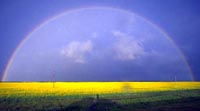|
|
|
|
|
Quiz Format |

|
|
|
1. Canola, wheat, mustard and potatoes are ***. a. angiosperms
2. Potatoes are grown primarily for the consumption of the ***.
a. flowers
3. In the canola plant, the fertilized ovule ***.
a. develops into the seed
4. Seed percentage viability indicates ***.
a. the temperature required to break dormancy
5. Alsike clover, alfalfa, winter wheat and fall rye are examples of ***.
a. forages
6. One of the most important macroelement that usually must be added in large quantities to fields in order to maximize crop yields is ***.
a. iron
7. Time to harvest cereals is indicated by ***.
a. the color of the seed
8. The Canadian Wheat Board markets the export of grain, primarily wheat and barley. Farmers who sell their crops through the Board ***.
a. receive two payments for their grain from the Wheat Board
9. Lignans have anti-viral, anti-fungal, antibacterial, and anticancer properties. A plant high in lignan content is ***.
a. mustard
10. The cropland of Saskatchewan has been divided into four areas based on ***.
a. the number of frost-free days and soil conditions
|
|
|
|
